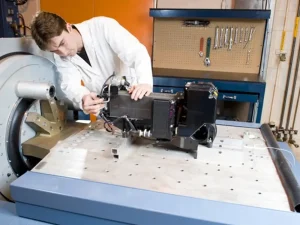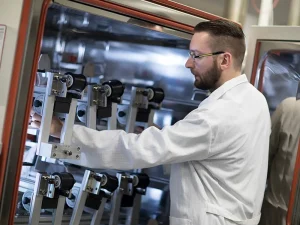IEC 60068- Environmental testing has transformed product quality assurance. In the past, the industries had to face many issues regarding the quality of the products. From returning to products getting damaged – industries faced a lot of challenges. But with IEC 60068 standards, things have become a lot easier.
IED 60068 international standards involve different environmental testing of products. These tests ensure that products launched by the company are reliable enough to be used. This reliability increases customers’ trust in the manufacturers. This testing standard seems complex. However, I’ll simplify their understanding in this article.
What is IEC 60068 – Environmental Testing?

IEC 60068 is an international standard for the testing of electrotechnical products. It involves different environmental testing such as temperature, humidity, shock, and vibration. These tests are conducted in specialized chambers. Products that pass these tests are considered reliable.
The International Electrotechnical Commission created this international testing standard. It gives various guidelines for testing any product. Remember, each product after its sale is used in different conditions. It can be used at different temperatures and humidity levels.
How would manufacturers know that their created products will perform well in those conditions? That’s why ICR 60068 Environmental testing comes into play. This standard has many sub-sections that cater to specific testing. For example:
- IEC 60068-2-1 is related to the testing of products at low temperature
- IEC 60068-2-2 is all about testing of product at high temperature
- IEC 60068-2-6 discusses the vibration testing of product
- IEC 60068-2-27 covers the shock testing of a product.
The above-given listing indicates that this standard has many subsections. Each covers a different test for the product. Remember, the product will have to undergo all those testing. If it remains in good shape, it is considered as durable. It will be approved for sale in the market.
Is following this standard mandatory for manufacturers? The answer is NO! However, those manufacturers that follow IEC 60068 are considered trustworthy. Customers tend to believe more in such manufacturers. Remember, a framework for environmental testing can be expensive to follow.
Quick Highlight: The tests are conducted in specialized chambers. Moreover, specific parameters must be followed. This makes this testing very expensive. Therefore, some manufacturers may not subject their products to this testing. However, it remains an excellent way of ensuring quality control.
What Types of Environmental Tests Are in IEC 60068?
As I said, IEC 60058 involves different environmental tests. Each test checks the product from a different aspect. For example, temperature testing checks the performance of products for temperature variations. Similarly, humidity testing ensures the testing of products in a humid environment. I’ll discuss each of those tests and their workings in the section below.
1- Temperature Tests

As you know, each product experiences different temperatures in the real world. So, IEC 60068 ensures that products are tested for those other temperatures. For example, IEC 60068-2-1 suggests testing the product at a very low temperature. It checks whether the product can withstand freezing temperatures.
Conversely, IEC 60068-2-2 suggests testing the product at very high temperatures. This test shows how a product would behave at different temperature levels. The product that withstands both low and high temperatures is marked as passed. Manufacturers can trust its quality and launch it for customers.
2- Humidity Tests
Different products from the electronics industry need to be resistant to moisture. If they are fragile, moisture will more likely affect their performance. So, a humidity test is conducted to see the product’s performance. Specialized environmental chambers are available for this moisture testing. A product that passes this testing remains strong against moisture in the air.
3- Vibration Testing
The IEC 60068-2-6 section of this standard concerns vibration testing. As you know, every product undergoes a different level of vibrations when used. Moreover, transportation, installation, and operation can also expose products to vibration. So, products undergo this vibration testing in specialized chambers.
These chambers emulate real-world vibrating conditions. This way, the operator notes the product’s performance against different vibration levels. Strong products can withstand this vibration, and vice versa. Remember, this testing is done in a controlled environment. Operators ensure different parameters at specific ranges.
4- Shock Test
IEC 60068-2-27 requires shock testing of a specific product. This test checks how a product will behave if it faces sudden shock. For example, a product can fall from a certain height or face a sudden impact. All these factors affect the product’s integrity. That’s why manufacturers conduct this shock test.
It tests the product by exposing it to a certain level of impact. Thus, it gives manufacturers an idea of whether their products can withstand shocks. The shock test mainly checks the durability of joints and internal components. Shocking testing chambers simulate real-world conditions.
5- Salt Spray or Corrosion Testing

Salt spray is a test that checks a product’s corrosion resistance. It involves spraying a mist of saltwater on the product. The salty water causes corrosion. If the product is weak, it starts to weaken. However, if it is durable, it does not get rusty. Remember, this method is generally suitable for testing the resistance of product coatings.
During this corrosion testing, operators set temperature and humidity at controlled levels. Humidity further provides an optimal environment for rusting. If a product gets rusty in the chamber, it indicates its durability. This testing is helpful for marine products.
Quick Highlight: Are you wondering how this test works? First, the product is sprayed with salty water drops. Then, it is left for a specific duration. The operator then checks for any rusty signs for a set duration. A product with some rust is considered weak.
6- Dust Test
Some products are for outdoors, and dust and other contaminants are inevitable. So, such products undergo this dust test under section IEC 60068-2-68. In this test, the product is placed in a dust chamber, and small, powdered dust particles are allowed to settle on it.
These tiny particles can go inside the product. It is considered reliable if it remains in good shape, and vice versa. Moreover, some manufacturers conduct this test to check the sealing of their products. If no particles enter the product, it indicates excellent sealing, and vice versa.
7- Light Exposure or Solar Radiation Test
Some products remain under the sunlight. Simply put, they remain exposed to UV rays from the sun. If the product is not strong, it won’t sustain this radiation for long. So, IEC 60068-2-5 suggests a light exposure test. It checks how long a product can sustain direct sunlight. Have you ever noticed direct exposure to sunlight degrades the coating?
This issue is due to continuous exposure to UV radiation. Knowing the product’s strength helps manufacturers in many ways. First, they try to improve the strength of their products. They also put light exposure instructions on product labels for careful use. This information helps customers know how long they can use the product in sunlight.
8- Electromagnetic Compatibility (EMC) Test
This testing ensures the proper functioning of products in areas of electromagnetic interference. 60068-2-82 suggests guidelines and standards for this EMC test. It checks if the product disturbs nearby devices by emitting or interfering with electromagnetic rays. Products that pass this test can work easily along with other electronics. It won’t disrupt the functionality of different devices.
9- Low Air Pressure Test
Electrotechnical products can be used in low-pressure conditions. An example is using products at a high altitude with very low pressure. So, this 60068-2-13 standard test product is for such conditions. The product is placed in the chambers.
The operator reduces the atmospheric pressure gradually. Products will start to behave differently if the pressure keeps going down. This low pressure can cause malfunctionality if the product is weak. It is approved as reliable if the product works even at shallow pressure. In the opposite case, the manufacturer will have to improve it.
How Does the Testing Process Work?
IEC 60068—Environmental testing is relatively straightforward. Specialized environmental chambers are available, and these tests are conducted in them. Remember, a specific chamber is used for each type of testing. For example, humidity testing will need humidity-controlled chambers. Similarly, vibration testing is done in vibration chambers.
These environmental chambers emulate real-world conditions. The operators keep the parameters under control. The product is placed in specific testing chambers. The operator switches on and notes the product’s behavior. For example, products may deteriorate at high temperatures.
Or it may start to crack at a very low temperature. The operator will keep an eye on the product’s condition. Once the test is done, a report is made. Based on the report, the product is approved or considered a failure. Remember, each testing chamber has its unique environment. So, products going to those chambers will face different conditions.
Benefits of Complying with IEC 60068
Complying with IEC 60068 is a win-win situation. It gives manufacturers credibility that they care about the customers. Remember, products that pass IEC 60068 get certifications. This certification acts as proof that the product is genuine and reliable. This testing standard involves many tests which check the product rigorously.
It gives manufacturers confidence that their products are high quality. They can claim the durability and longevity of their products. Manufacturers can label their products with IEC certification. This helps customers trust their products. IEC 60068 is an international standard. It means that products that comply with it are acceptable worldwide.
Moreover, the competition in the manufacturing industry is scorching. Every manufacturer tries to get ahead of the competitors. So manufacturers that put their product under such testing win the race. It becomes a symbol of reliability and trustworthiness. So, manufacturers can charge more for such products due to their better quality.
Remember, customers are willing to pay more for durable products. Ultimately, I would say IEC 60068 also provides peace of mind for customers. They can blindly trust a product if it complies with IEC 60068. They don’t have to worry while buying it. In short, it assures that the product will sustain harsh environmental conditions.
Quick Highlight: These international standards allow manufacturers to spot product weaknesses. They can redo things and make required corrections to enhance the quality. Launching a faulty product in the market is disastrous. Those manufacturers that comply with IEC 60068 are considered reliable.
Frequently Asked Questions
What is the IEC 60068 standard for?
This standard involves setting different tests for electrotechnical products. The International Electrotechnical Commission organized this standard. It checks the durability of the product under various conditions. Those conditions are simulations of the real world.
What is the standard for environmental testing?
IEC 60068 is the standard for environmental testing. This standard checks electrotechnical products in many aspects. This standard is all about different tests, such as vibration, temperature, and humidity.
Is complying with the 60068 standard mandatory for manufacturers?
No, complying with the IEC 60068 standard is not mandatory. However, complying with it gives manufacturers reliability and trustworthiness. Products tested with this are durable, giving them a good name in the market.
Conclusion
The IEC 60068 standard is an excellent way of testing any product. It helps manufacturers know the flaws in a product. So, they take proper steps to remove those faults. In this way, only durable and high-quality products go into the market. This helps manufacturers win customers’ trust and credibility. In this article, I’ve explained everything about testing standards.